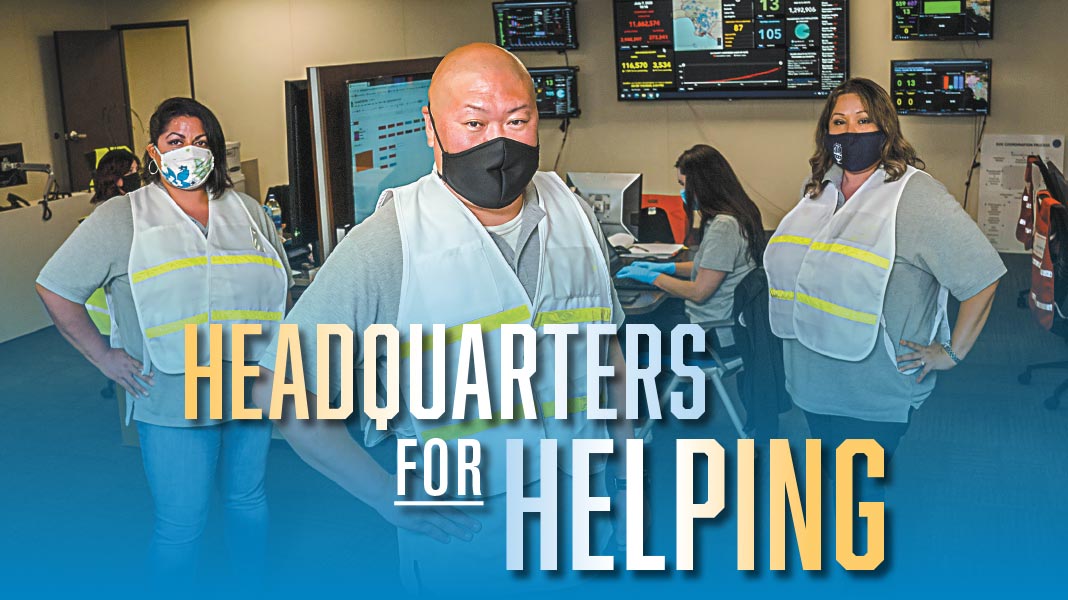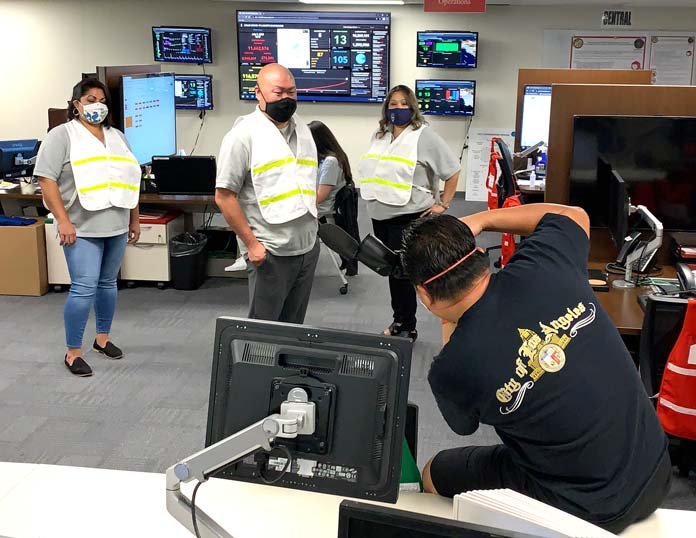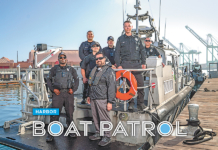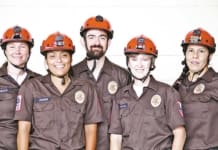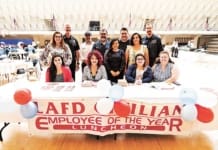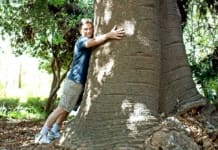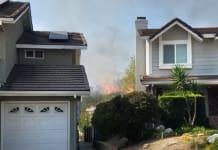Photos by Summy Lam, Club Director of Marketing; and courtesy Rec and Parks
Five years ago, when Rec and Parks began making serious plans to upgrade its emergency preparedness and create an operations center, the department figured that an emergency was inevitable. Knowing Southern California, that could be an earthquake, wildfires, floods, a foreign attack, or other calamities. It even planned for a virus outbreak.
But not quite like this.
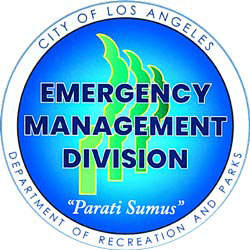 When Rec and Parks opened its Dept. Operations Center (DOC) in January, it could not have known that a pandemic was about to envelop the world. But sometimes the timing is fortunate. From its new DOC in Rec and Parks’ Central Service Yard, the department’s Emergency Management Division has managed some of the biggest mass care missions the City has undertaken to care for Angelenos – sheltering more than 1,000 homeless and vulnerable citizens to help protect them from the virus; providing more than 50,000 showers to keep those sheltered clean; offering health and mental health screenings and counseling to improve their lives; providing childcare for emergency workers; and many other services. As of August, these emergency services continue.
When Rec and Parks opened its Dept. Operations Center (DOC) in January, it could not have known that a pandemic was about to envelop the world. But sometimes the timing is fortunate. From its new DOC in Rec and Parks’ Central Service Yard, the department’s Emergency Management Division has managed some of the biggest mass care missions the City has undertaken to care for Angelenos – sheltering more than 1,000 homeless and vulnerable citizens to help protect them from the virus; providing more than 50,000 showers to keep those sheltered clean; offering health and mental health screenings and counseling to improve their lives; providing childcare for emergency workers; and many other services. As of August, these emergency services continue.
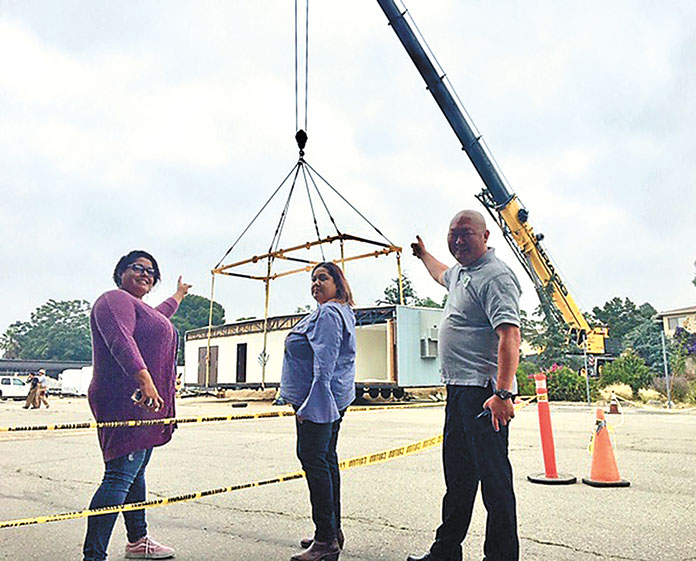 Getting to this point has been a long process. Rec and Parks first had to create an Emergency Management Division, then staff it and write procedures and regulations; then implement a substantial training program; and finally create space for emergency management. That has all happened, and just in time.
Getting to this point has been a long process. Rec and Parks first had to create an Emergency Management Division, then staff it and write procedures and regulations; then implement a substantial training program; and finally create space for emergency management. That has all happened, and just in time.
In this month’s interview and images (after the STAFF section) – the first time Rec and Parks has opened its DOC doors to outside press – read about how it all came down, how it’s going, and the lessons the emergency team has learned.


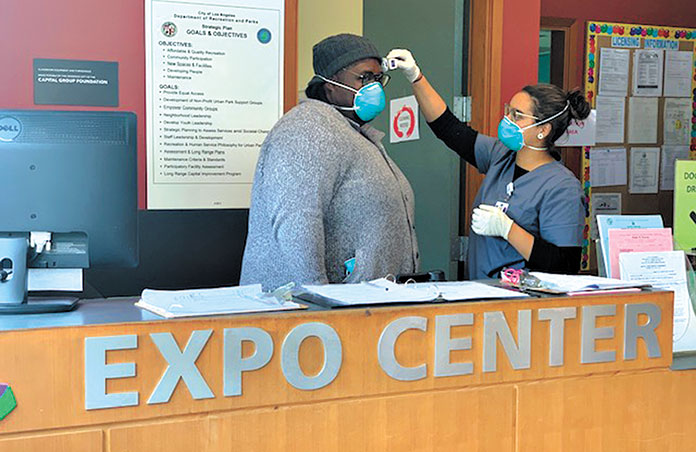

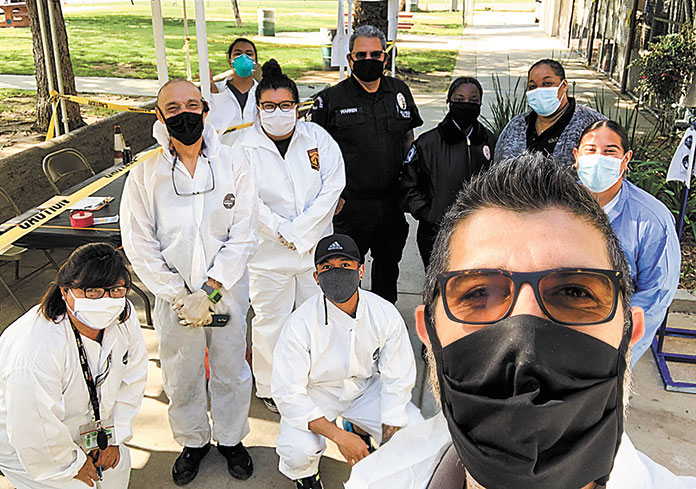
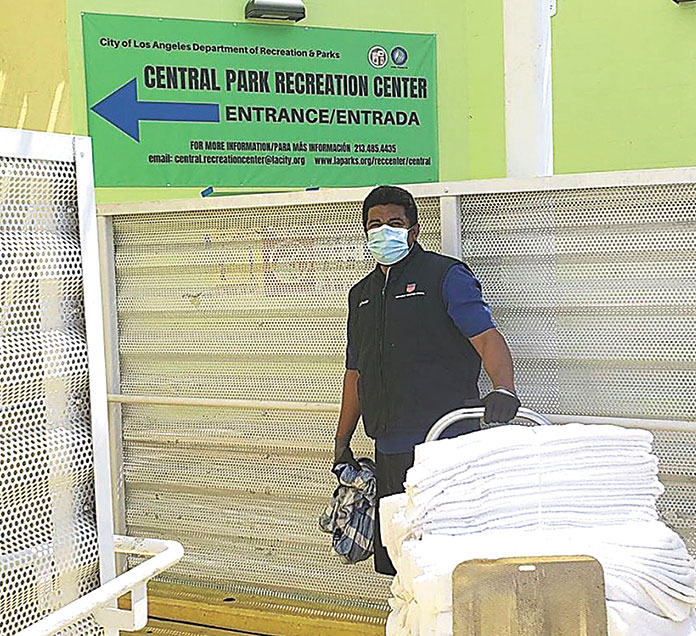
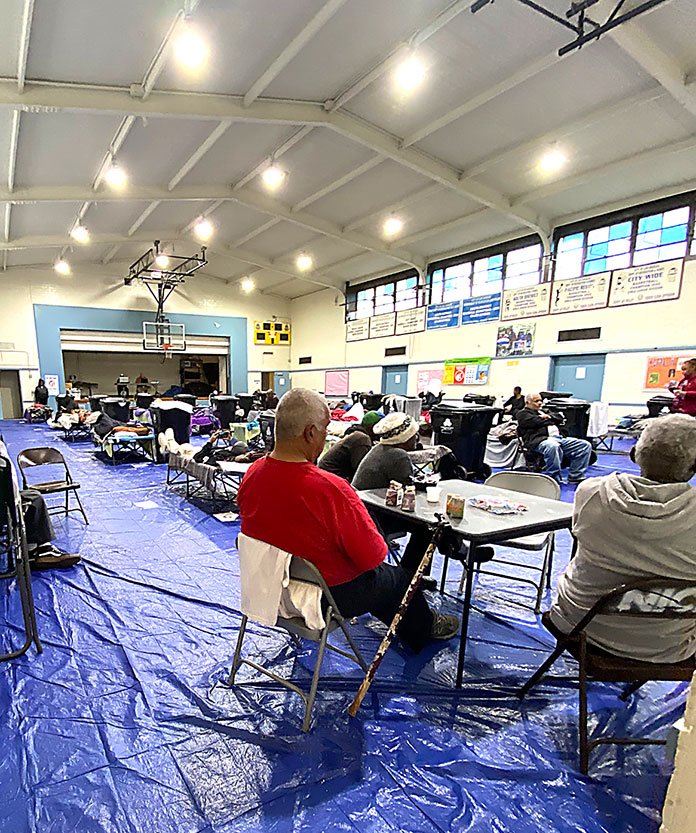

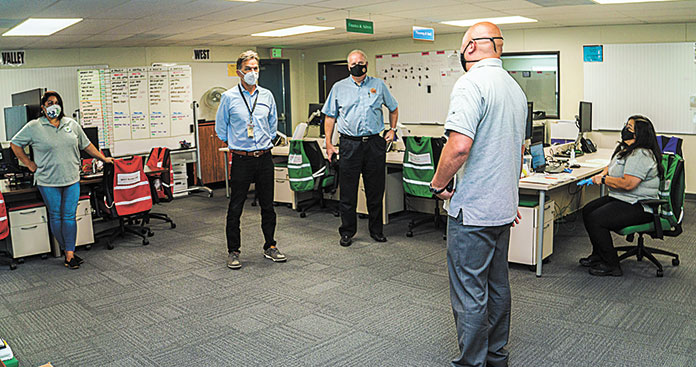



The Gold Standard of Mass Care
 On July 7, Club CEO John Hawkins and Alive! editor John Burnes interviewed Rec and Parks’ Emergency Response Action Team (ERAT) members Jimmy Kim, Superintendent, Operations, 20 years of City service, Club Member; Sonya Young-Jimenez, Emergency Management Coordinator II, 21 years, Club Member; and Brenda Aguirre, Emergency Management Coordinator, 14 years. The interview took place at Rec and Parks’ brand new Dept. Operations Center (DOC) on the Rec and Parks campus in North Atwater. It marked Rec and Parks’ first public welcome to the new DOC.
On July 7, Club CEO John Hawkins and Alive! editor John Burnes interviewed Rec and Parks’ Emergency Response Action Team (ERAT) members Jimmy Kim, Superintendent, Operations, 20 years of City service, Club Member; Sonya Young-Jimenez, Emergency Management Coordinator II, 21 years, Club Member; and Brenda Aguirre, Emergency Management Coordinator, 14 years. The interview took place at Rec and Parks’ brand new Dept. Operations Center (DOC) on the Rec and Parks campus in North Atwater. It marked Rec and Parks’ first public welcome to the new DOC.
All five participants, plus photographer Summy Lam, socially distanced for the interview.
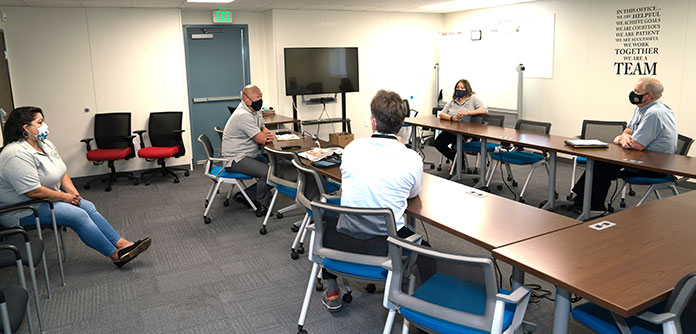
Alive!: Thanks for welcoming us today. This new center is impressive.
Jimmy Kim: Sure. I like your masks, with the City seal!
These are from the Club Store. Shameless plug!
Jimmy Kim: Right. Nice. Here at Rec and Parks, we the department issued masks to every one of our employees. Everybody gets one mask at least.
Tell us how you got here – your career up to this point.
Sonya Young-Jimenez: I started as a part-timer. I worked for seven years programming summer camps and after school clubs. Then I worked my way up the ladder through Recreation to became a Coordinator, a Director, then a Senior Director. Around 2011 or so I got on the Emergency Response Action Team, and I just loved it. It was one of my favorite committees to be on, and I loved being with the team and learning a lot about emergency management.
Around 2017, [then-Assistant General Manager and Club Member] Kevin Regan asked me if I was interested in doing Emergency work, too. I didn’t know about doing them both at the same time, but I decided to take a leap, and I’ve been doing Emergency for the last three years now. I took the test and became a full-time Emergency manager.
Did you ever think you’d be sheltering people or doing emergency operations? Did you think that that was where your career was going?
Sonya Young-Jimenez: No, never. I didn’t even know that was part of our mission. In the early years it wasn’t even talked about that that was one in the Charter. We had a couple people who helped do emergency response but never the way we do it now, not to the extent that we would be sheltering. With so many wildfires every season, I feel like we’re always in some activation. I never would have thought as a part-timer that this is what I’d be doing.
But this division has been amazing. With all the emergency processes and plans we have, Jimmy knows how to put those together and knows how to get people to follow them. That’s really what makes this division special.
So Jimmy, same question. How did you get here?
Jimmy Kim: I started back in ’94 as a junior lifeguard in the Summer Youth Employment Program. That got me interested in becoming a lifeguard, so I was a junior lifeguard. In 1995, I became a locker attendant for a couple of months. Then I trained and became a full lifeguard in ’96.

Where was that?
Jimmy Kim: I started as a Junior Guard at Griffith Park. I was there for one summers. And then I was a Locker Attendant at E.G. Roberts Swimming Pool for the fall and in ’96, I was a Reserve Lifeguard. I was a hustler, filling positions all over the place. In ’97, I got more a permanent position. I worked at Echo Park, then became a part-time pool manager until 2000, a PM 1. I became a Seasonal Pool Manager II, still part-time. I went full-time as an Aquatic Facility Manager in 2005. And that is when I took on in Aquatics the role of the Training Officer and developed our Lifeguard Academy into what it is today.
From 2005 till about 2015, I moved up the ranks in Aquatics. And like Sonya, I never looked at Emergency Management. I thought my endgame was going to be as an Aquatic Director. I made it to Aquatic Facility Manager II and III. I oversaw Expo Center for about four months. And then the opportunity came at the time to do emergency work.
This is how I became an Emergency Manager: Back in 2014, I was still in Aquatics. I did pretty well in terms of writing and developing training plans. I was at a Starbucks with my then boss, Trish Delgado, Brian Lam and my Assistant General Manager, Kevin Regan. Kevin was talking about a lawsuit and needing to develop standard operating procedures. There was nothing at that point. He looked at us for an answer, I lifted my head to the side and I raised my hand and said, “Sir, I think I can do this.” He looked at me and said, “Dude, what’s your name?” I said, “Jimmy Kim.” And he says, “You’re my guy. I want you to work with Brian.” That literally opened the door for me, and I ended up writing the first initial 21 standard operating procedures as well as our sheltering handbook. That actually got reduced to about 14 after they boiled it down. Two years later, the Department decided to actually hire emergency managers, and I became one. I was appointed to an EMC II position about two years after that, to oversee Emergency Management. Then Sonya and, later, Brenda, came on to Emergency Management.
About two years ago the Superintendent position opened up. I inter-viewed for that and was appointed. Now I oversee both Emergency Management and my initial, you know, love, Aquatics.
That’s a success story.
Jimmy Kim: Yes.
Did you ever think you’d be doing emergency work and sheltering mass amounts of people?
Jimmy Kim: I knew about sheltering and disasters. But to the extent that we’re doing it now, no. I’m so proud of this Department and this Division. If you think about where we came from to where we are now, we’ve come a long way. If you look at City in terms of emergency management, usually they talk about Police and Fire and and Emergency Management Dept., because of how successful they’ve been, and the good work they’ve done. But now, in terms of a civilian department, we’re top of the line, like the gold standard. People actually say, “Hey, if you want to set up emergency management operations properly, go look at Rec and Parks.”
Sonya Young-Jimenez: With the little space we had before this building, we made it work and had all the units we needed.
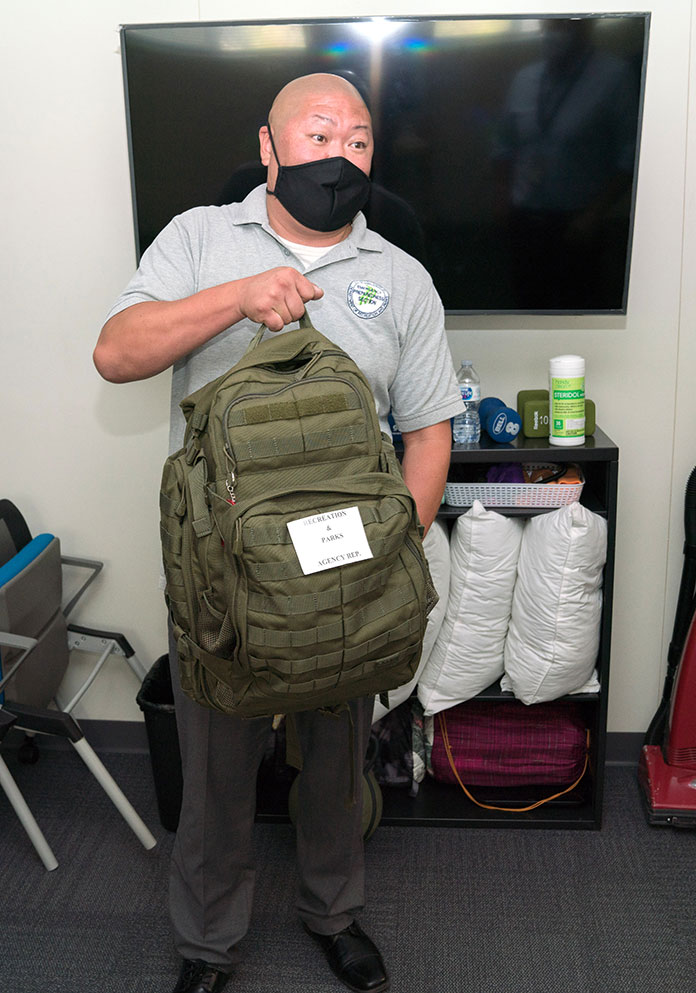
How about you, Brenda?
Brenda Aguirre: I started with the City as a Sr. Park Services Attendant. This was back in 2006. My intention was to become a Human Resource Manager because that’s what I was doing in the private sector. I had been with several retail companies. I was a Regional HR Manager for Best Buy at the time that I applied to the City, and I just wanted to get my foot in the door. I was told, “Apply for whatever you qualify for and go from there,” and that’s exactly what I did.
Then we all know what happened in 2008, the financial crisis. The City went on a hiring freeze, so I spent a lot of time in Operations here at Park Services and several revenue-producing facilities. I was promoted to a Principal and later took on the whole division. So I was a Division Supervisor for Park Services working directly for the Superintendent of Griffith Park. And I became the Film Liaison for the Department and did that for about five or six years. That was quite a challenge because I was never interested in the political side of things, but you can’t say filming without being political. That was just one of those learning experiences for me, but I grew a lot from that position.
Then I started with the Emergency Response Action Team. I was interested in it. It’s an operational thing, so it was very natural for me. When this position became open, I tested for it. I was on several different lists for Management Analyst and a few other things, but this was something that I was really attracted to because it is challenging. It’s a position for adrenaline junkies because it starts out usually as a lot of chaos because of whatever the situation is, and then the chaos becomes more and more manageable. I won’t say that I specifically thought about sheltering earlier in my career, but it certainly is something I enjoy doing, so I’m happy to be here. This is my first year as an Emergency Manager. I started in May of last year, right before we got this new building, so I planned my moves correctly.
The New Center
So let’s talk about your new operations center, which you were about ready to present to the public when the pandemic hit. How long has this Dept. Operations Center been up and running?
Jimmy Kim: We were supposed to go public in January. We actually moved in in December.
Sonya Young-Jimenez: Early December.
Jimmy Kim: We were going to do a public opening in March, and then COVID hit, and we put this building into use.
What does this new building allow you to do?
Jimmy Kim: So, by Charter, Recreation and Parks is responsible for mass care, sheltering large groups of people. In times of local emergency or disaster, Recreation and Parks is responsible for providing and coordinating all shelter activities for the City of L.A. We provide sheltering and mass care for anyone who’s been displaced by a disaster. This specific building is to help the department coordinate that responsibility. It’s a huge undertaking because we have to provide for anyone within the City boundaries. It doesn’t matter if you’re a citizen or not, if you’re within our boundaries, we will provide some type of mass care sheltering.
We partner with other organizations in mass care, namely the Red Cross. And then we also work with Animal Services very closely, because when we talk about sheltering, there is an animal component. We also work with Department of Disability. In the last 10 or 12 years, being accessible to people with disabilities has been huge in terms of the emergency management field. We’ve also worked very closely with the LAUSD. So this building allows us to manage the Department’s response in coordination with the City’s Emergency Operations Center.

How long have you been working on getting a building like this together to have all your operations like that in one place?
Jimmy Kim: I became an Emergency Manager back in 2015. We started off in an office in the Golf Trailer. We quickly realized that the responsibility of this Department is so huge, how do you man-age Mass Care for an entire city in an office that we shared? We bartered with our then-Assistant General Manager, Kevin Regan, to take over an interpretive trailer that we have at the back of the yard here. Nobody had touched it for over 15 years. The door was always left open. We bartered back and forth. I asked to take it over, and he said he had no money, but we could if we wanted. There was no air conditioning, no nothing. But that was the conversation. We moved into that space about two or three months after I became an Emergency Manager. We started off with a bunch of fans, and then he came in one time and said, “I feel really bad for you guys!”
We asked Park Services for assistance, they had some funds that we could potential use for an air conditioning unit. They did, and we put that in. We were in there for about four years. That space was small. Then, with the support of our General Manager and our Executive Officer, we got support to utilize FEMA recovery money from the Northridge earthquake and other disasters to put into building a Department Operation Center. Starting in 2015, this Department got very serious about our role in mass care and shel-tering in part because of a lawsuit against the City regarding ADA compliance and said that our emergency plan was not whole com-munity. That’s what kick-started the expansion of our emergency management division. Once we got into that small building, lots of disasters happened. We had the Saddle Rich Fire. We had La Tuna. We had the Fig Plaza fire. They all cemented the support for us to build a Department Operation Center. All that lead to this current building, which was more than two years in the making. There were delays in that, too, but it’s all good. Here we are.
So there was nothing quite like this before.
Jimmy Kim: The concept was always around, but there was never a true location where we would unify and coordinate from. During the Da Vinci Fire, we had some plans, but we weren’t as developed at that point. We were actually at the Golf Conference Room by default, where our executives sat in and made decisions. That would have been our Department Operation Center. But this didn’t exist then.
But you had written the plans at least.
Jimmy Kim: Yes. But there’s always got to be a person who’s going to say, “Okay, let me execute it.” We have a department emergency plan like all City departments, but during the Da Vinci fire we weren’t quite ready to lead the coordination of emergency operations for Rec and Parks.
Brenda Aguirre: I want to give a shout-out to ITA on this – the last component of this building that we didn’t quite have completed was that we didn’t have proper internet connections. And when this pandemic struck and we were tasked with opening up these emergency shelters for the homeless, it became one of those things where I couldn’t do anything because our connection to the Internet was bad. I was frustrated by not being able to print or if my Wi-Fi connection dropped. Anthony Moore of ITA sent his team on the weekend and got us up and running the same day. I just couldn’t believe it. When they got it working I wanted to cry because I could actually print something. Ever since it’s been fantastic. They were our heroes, for sure. Lifesavers.
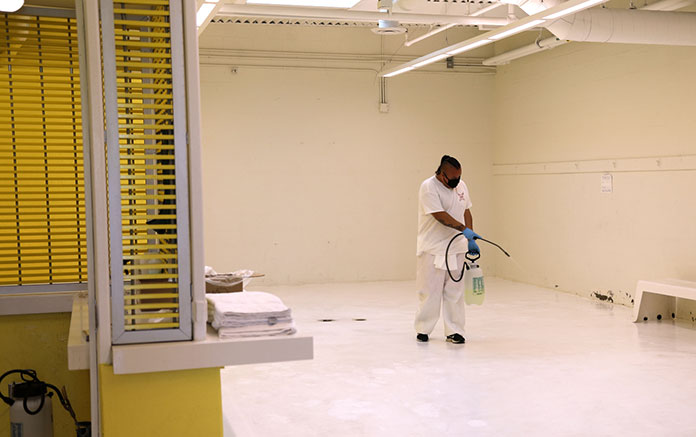
Hear, hear for ITA. Now, after all your work, after all your years getting the operation plan in place and getting a facility where you could do all this, you open in January and this crisis hits in late February or even earlier.
Jimmy Kim: Yes.
That’s unbelievable. The timing could not have been better for the City.
Jimmy Kim: Right.
You could never have known what was coming. I mean, a virus pandemic.
Sonya Young-Jimenez: Right.
Jimmy Kim: It’s a testament of why we did this. Even when we were in our smaller building we had smaller activations. Prior to this I think our longest activation Citywide was, what, seven days?
Sonya Young-Jimenez: Yes. The Creek fire.
Jimmy Kim: In terms of an Emergency Operations event in the City, that’s been the longest.
Until now.
Jimmy Kim: Until now.
Is there any connection between the Department’s emergency operations and the ongoing homeless situation? Is this primarily for disasters, or is there any connection to the ongoing surge in homelessness on the street? When I hear shelter, I think homeless, but I realize though if there’s a big fire, there’s shelter need there.
Jimmy Kim: I also serve as the Department’s Homeless Coordinator, and Brenda is our operational lead. She leads the homeless response for me.
Does every Department have a homeless coordinator?
Jimmy Kim: Yes. We’re all connected to the City’s Comprehensive Homeless Strategy. Because of the emergency nature of homelessness, that responsibility is nestled under emer-gency management. Brenda oversees two staff members in the Unified Homeless Response Center at the EOC.
Has anything changed in the last year with sheltering homeless or is that something still in the works for Rec and Parks?
Jimmy Kim: Generally this department does not do homeless shel-ters because that’s not under our operational purview. But within the last 12 months, during the winter storms this past year, at the request of the Mayor’s Office, some Council Offices, and with the rise of homelessness, seven Rec and Parks centers converted into warming centers, overnight winter shelters. People would come in about 6 p.m. and then leave the next morning at 6 or 7. And then we would do a cleaning and then we would open up to the public..
You three were responsible for making that happen?
Jimmy Kim: Yes. And field staff, of course. The field staff is the most important component of what we do.
Training
That must involve training your staff.
Jimmy Kim: Exactly. We train our entire department in mass care and sheltering. Our full-time recreation and aquatic staff, the ones who work in the field, are trained to take on mass care shelter roles. Whether it be shelter and management, or dormitory management, or logistics management, or feeding, this entire department is trained to run shelter operations.
Sonya Young-Jimenez: And now they’re really trained up. We’re applying everything in the training during this crisis.
Jimmy Kim: Every year we host what we call the Annual Emergency Preparedness Workshop, we cover topics from being prepared at home to sheltering topics. We’re also involved in mass prophylaxis, if there were a biological attack on L.A., our staff would be first responders to prophylax the entire city. A lot of our centers are also used as medical points of distribution. We have provided training to staff in what is called Resilient Responder Training, which is mental health training. We had people from the Huntington Institute come in and train people on the things that they may see in emergency operations and then dealing with that type of thing. Just recently, Sonya put together and managed a mental-health training session for all of our shelter workers. They do a weekly check-in where they talk about mental health.
But the most important thing is that our department has been train-ing and getting ready for this point for the last six years. It takes a lot more than the three of us. This DOC has 25 seats. Our Emergency Response Action Team, ERAT, is comprised of about 38 Recreation and Parks full time staff that we train monthly.
Sonya Young-Jimenez: It includes staff from all different sections of the Department – Facility Directors, Aquatic Facility Managers, Maintenance Supervisors, Administrative Clerks, a wide variety.
Sonya Young-Jimenez: The training courses are what sparked my interest. Before that, I didn’t even know that we had Emergency Management. Someone said, “You want to try it?” That’s how I got on board.
Brenda Aguirre: We need more people!
Jimmy Kim: Yes! Realistically, there’s no way the three of us can fully manage 24/7 on a seven-day-a-week operation.
Brenda Aguirre: It’s just not humanly possible for us.
How many employees are operating as Emergency Service Workers during the pandemic?
Sonya Young-Jimenez: I think it was 1,000 at the height, but now it’s fewer.
Jimmy Kim: About 200 or 300 employees now.
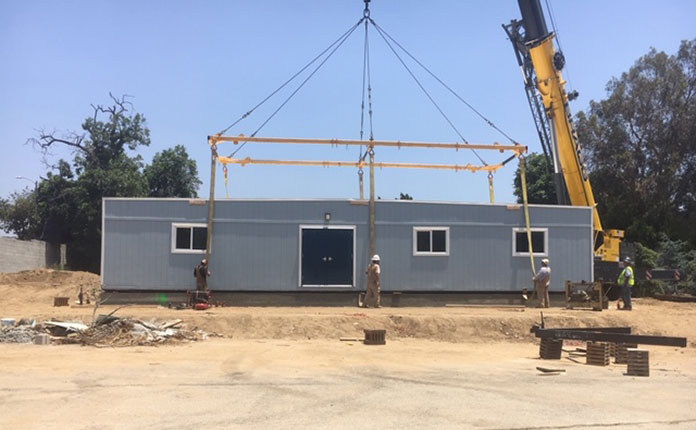
The Making of a Good Shelter
Go back to the original ideas and the vision of Emergency Operations. What was the ultimate disaster that you built the DOC for? Fire? Earthquake?
Jimmy Kim: Earthquake.
No one was thinking pandemic.
Jimmy Kim: No.
Sonya Young-Jimenez: Earthquake was the big one.
Jimmy Kim: Yes. And then fire.
Okay. What other disasters did you plan for?
Jimmy Kim: Adverse weather. Cooling centers. We do that several times a year.
Sonya Young-Jimenez: And the debris flow, when we had the rainstorms and mudslides.
And all those disasters are connected to shelter?
Sonya Young-Jimenez: Yes. They have to evacuate people from their neighborhoods.
Jimmy Kim: Anything that has to do with some type of evacuation or when it displaces residents has to do with shelter.
Sonya Young-Jimenez: And I was thinking some of the other incidents and activations we’ve had with, like, gas. Gas leaks or there was a big water main break one time.
Jimmy Kim: Yes.
Sonya Young-Jimenez: If it’s under an apartment building where there’s a lot of people who have to be displaced, then we’ll be called for that as well.
In a disaster the first thing I usually hear about are the Red Cross shelters. Is every Red Cross shelter in the City of LA connected to the DOC?
Jimmy Kim: For the most part, about 99 percent of the time a Red Cross shelter is connected to the DOC if it’s a City-led response, if the incident happens within our boundaries, then Rec and Parks has to be involved. The priority is City-owned facilities first as shelters, then the LAUSD sites and then all the other potential locaitons such as nonprofits, churches, and nongovernment agencies, in that pecking order.
Do some Rec Centers work better than others? Do you have a top five?
Brenda Aguirre: It depends on the amenities that it offers. It has to be inclusionary and accessible. We rate our sites based off of our building and our square footage, whether or not they’re accessible and what they need. Sometimes it needs a slight modification, adding a ramp, or fixing something in a restroom. A lot of times we look at sites that have pools attached to them, so that we can use the shower facilities. We already have them rated by tier, and we work with the Red Cross and the Department of Disability for those ratings.
That makes complete sense.
Emergency Field Service
Let’s talk about the specific things that Rec and Parks employees are doing as part of their emergency duties here.
Jimmy Kim: Sure.
Let’s talk about the specific things that Rec and Parks employees are doing as part of their emergency duties here.
Jimmy Kim: Sure. At our peak we had 24 shelter locations and two trailer sites, only trailers. Very early on in this activation the State offered trailers to the City.
Sonya Young-Jimenez: There were about 535.
Wow, where did you put them?
Jimmy Kim: Initially they got checked into our Hansen Dam Recreation site, and from there we took about 232 trailers and put them at some of our shelter locations. The biggest sites we have are Friendship Auditorium, Rancho Cienega and Cheviot. That’s where there are the most trailers.
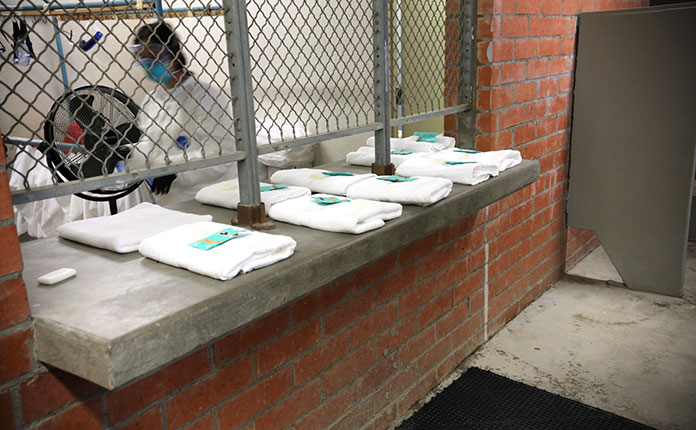
When did the emergency orders start?
Sonya Young-Jimenez: March 12.
Jimmy Kim: We heard about COVID coming around early March. It didn’t really hit reality until mid-March. Yeah. And then it was just fast tracked from that. We have a pandemic plan, but it never involved mass care. The pandemic plan included what we’re doing now – social distancing, wash your hands frequently, and so forth. But the components that were new were housing the homeless population, and adding the pandemic piece, with the physical distancing. That was new.
Brenda Aguirre: The homeless people within the City were identified as some of the most vulnerable, so the Mayor and the rest of our leadership decided that we needed to do something to protect that community to save their lives. We knew that if we left them out, they have more exposure. It’s a very vulnerable population. They have a lot of needs. They have a lot of health issues. When we hear about COVID, all of those things that make someone the most vulnerable, – the elderly, people with underlying medical conditions, people who don’t treat their medical condition, that’s our homeless community. That’s when the mission given to us for us to take over.
Sheltering plans fit for just about any community, but I think that this particular activation brought about a lot of new challenges that I’ve never seen before. We learn so much about things that we just didn’t know about.
Sonya Young-Jimenez: The City was telling everybody to stay home, but we’re telling them to come in and we’re going to put you with a lot of people in a shelter.
Was the purpose of the sheltering for the homeless just quarantine? What does mass care mean?
Jimmy Kim: It’s the whole package. It’s not only to get them out of the elements and putting a roof over their head, but also provide services. All of our sites have a component of the Los Angeles Service Authority as an outreach provider. We also have a Department of Mental Health to deal with mental health issues of some of our clients. We have just a whole slew of things that we provide. We provide shower services, hot meals and all those types of things. Mass care is a whole combination of everything, only one of which is sheltering.
Brenda Aguirre: Because we opened so many sites, we had a lot of pool [aquatic] sites, which I mentioned earlier. We like to use those because we like to have the ability to shower folks within the same property. We leaned on Sanitation with its roving mobile hygiene units to bring some of the units out. And also we rented units just so we had one for each shelter, The Department of Sanitation and Environment assisted us in intake of clients, and they’ve also helped us with the shower operations.
Why the pool? Is that because, in the event there is no water, so you pull water from the pool?
Jimmy Kim: No. It’s because of the shower.
Pools always have showers.
Jimmy Kim: Correct. Not all Rec Centers or trailers do.
How many showers have you provided?
Jimmy Kim: About 50,000. So far.
That’s incredible.
Brenda Aguirre: Right.
Jimmy Kim: The Aquatics Division very often doesn’t get a lot of kudos. But an integral part of shelter operation is the shower operation piece. We shifted aquatic staff very early on into emergency operations. All of Rec and Parks has stepped up to the call of disas-ter service workers; they are all unsung heroes. But I feel the role Aquatics plays is always understated. They’ve been phenomenal not only because I oversee the division, but because of the call to action that they responded to. They all shifted from doing aquatics activities to provide showers. at the DOC’s request. And they’ve been doing this nonstop for as long as we’ve been open with shelter operations. I mean, 50,000 showers!
Brenda Aguirre: One of the things that I really appreciate about the Aquatics team is their ability to turn on a dime. They are our logistical support, so even though most of our purchasing is happening in here, they are the ones who are acquiring everything. Everything is shipped to Aquatics, and Aquatics is inventorying it and are able to stage it out. And then they distribute it to all the Centers. Every PPE, every thermometer, everything is brought to Aquatics and distributed out. We had donations as well that were coming in, which is unusual. We have socks that need to go out. Things this community needs more so than the other communities that we typically shelter, is handled by Aquatics. They didn’t miss a beat. And they were operating seven days a week sending all this stuff out; they would get a request in and would just ship it right over, and it was better than taken care of. You would never hear about that need again. The thermometers would need batteries and they would anticipate that. They developed their own system of inventory tracking and keeping the paperwork. Our job won’t be finished when the shelters are shut. We have to go back and track all the expenses, and they’ve been really great about that.
Wow.
Brenda Aguirre: We use them for everything.
Did you reach outside the department? How did you know that Sanitation had a roving shower truck?
Jimmy Kim: Rec and Parks has a vendor list, but General Services does all of the procurement for the City. They have a master list. The DOC coordinates the Department’s response. But we coordinate with the City’s EOC, which has every single City department housed in that building. We were able to connect with them.
We have an emergency purchase card. Normally it’s a $250,000 limit per month strictly for emergencies. Literally two weeks into the activation, our CFO Noel Williams told me, “Hey, I think you guys are going to need more.” She was right. So we were able to buy a lot of the things that we needed to activate these shelters.
Normally our partner in sheltering is American Red Cross. Usually they’re the ones who come in and manage the shelter. For this particular activation, they didn’t classify housing homeless individuals as a nationally recognized disaster.
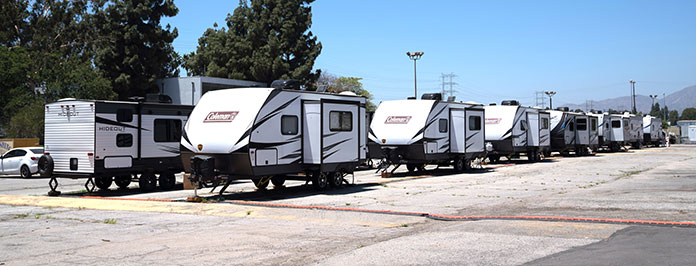

So you’re on your own.
Jimmy Kim: So we were on our own. They did, however, provide us with a lot of cots that we didn’t have very early on. And we reached out to them for guidance because they are the sheltering experts. But this activation is unique in that all of our shelter sites are 100 percent Rec and Parks City employees with our brothers and sites from the City Library. Plus we have partners from Sanitation there. We have LAPD Officers there, 24 hours a day, A-shift, B-shift, throughout the entire duration of this activation
And Transportation I would assume.
Jimmy Kim: Absolutely. Paul Weinberg from DOT. He is the man!
Is it still live, the activation?
Sonya Young-Jimenez: Yes.
Jimmy Kim: It is, yes.
How many of the 230 trailers are being used right now?
Jimmy Kim: All of them, 230. We keep track of all of that on our video dashboards in the main room. I’ll show you. That data is provided to us by the HSAC, the Homeless Security Advisory Council LA. They provide a platform called SALUS, and it’s shared by most City departments. It’s 100 percent free for the City. It gives us situational awareness to put all of our data in one place. You’ll see what’s active, how many sites are open, how many people we have. It breaks it down all the way to how many men, how many women, and things like that.
How many people can shelter in a trailer?
Brenda Aguirre: The max is two, but the trailers have specific criteria. They have what they call the Tier 1 clients – over 65 or in extremely vulnerable medical condition. Not everybody qualifies.
Jimmy Kim: When we started, we identified a need for 42 trailers because we were tasked to shelter 7,000 people. But very quickly we learned that the calculations that we had for sheltering capacity didn’t include the six-foot requirement. We thought we had enough capacity for 7,000 beds, but I think we had only 1,021 beds. We could fit only two people per trailer, not what we were expecting. It was a big learning experience.
And we still have to be ready for wildfires or earthquakes. So we continue to do calculations to be ready for anything.
How many are you sheltering now?
Brenda Aguirre: 289 right now.
And is that 100 percent homeless?
Brenda Aguirre: Yes.
Personal Quarantine
Brenda Aguirre: One thing I want to note – Jimmy was sick at the beginning of the activation. He had this really bad cough. I don’t think he felt that bad, but he was on every conference call twice a day, leading the conference calls. He was calling over here all the time telling us all these different things and ideas that would pop in his head from his house with his three kids out there and his wife.
Jimmy Kim: I got sick March 20 and then, as soon as the City started doing first responder testing, my GM said, “Hey, I need to get you tested.” A week later I got tested. And then I came back negative and then I started coming back into the office. I think I was out for a good 14 days.
Were you quarantined?
Jimmy Kim: Self-quarantined, yes. We didn’t know if I had COVID or not. My wife supported me through the quarantine and even still managing her real estate career and taking care of the kids while I am at work. Shout out to my wife, Mireya Arias Kim.
Do you think you had it?
Jimmy Kim: We thought that I may have had it. One of our friends worked in a hospital setting and they got really sick. My whole family got really, really sick, and so we thought we had it. My wife took the antibody test and she didn’t have the antibody. So I don’t think we had it. And I came back negative, so I think I was clear.
You stayed away to keep your staff healthy.
Jimmy Kim: Right. We have masks and gloves here as part of our plans, but because of the pandemic and what that meant, a lot of our employees had a lot of fear. We work very closely with the [County] Department of Public Health to make sure that, one, we have the proper personal protective equipment; and two, to go above and beyond that with coveralls, gloves, surgical masks. They have safety glasses, booties, the whole nine yards. We wanted to make sure that our staff was safe. And a testament to that is that, to date in terms of our shelter operations, none of our employees has gotten COVID through the shelter.
Validation and Realization
Has this pandemic changed the fabric of the DOC for the future, in terms of your responsibilities?
Jimmy Kim: I don’t think it’s changed, but what it has given us is validation. Significant validation. A lot of times divisions or departments can go for years without ever utilizing their emergency plans. And now we can say that the DOC works. The plan we created works. The training that we provided the staff was useful. The DOC as an operations center is always multi-functional, so whatever gets thrown at us we have to handle.
Sonya Young-Jimenez: We’ve made adjustments.
Jimmy Kim: Right. One of the things we’ve discovered is that, to a certain extent, we could do it virtually if we had to. Right now in the DOC we have a staff about four people. But we have people working virtually connected and checking in, using all the resources that the City has under Google, Zoom, and those type of platforms. We’re using them to function and have situational awareness. Technology is a joining piece. Very early on in this activation, it took us a minute to say, wait a minute, “We don’t all need to be here. In fact, we shouldn’t all be here. Let’s start pushing out and working remotely and be able to still fulfill our mission.” And quite honestly, we’ve done it. All of our tentacles that are out there, so to speak, are making it work.
Okay another thing you’re doing in the field – childcare for emergency workers.
Jimmy Kim: It was strictly for first responders. Initially at the peak we had identified about 40 sites, although I don’t think we used that many. We worked very closely with [County] Dept. of Public Health. Sophia Pena-Cortez, the Assistant General Manager, oversaw that operation and others in the Department helped coordinated it. It really didn’t take off as we thought. At the peak, the most that they had was about 24 kids at more than 16 sites. Very early on, people were scared. A lot of people kept their kids at home. I understand that.
Is that still going on?
Jimmy Kim: No. It ended last Friday.

Life Changing
Tell us a favorite memory you’ll always have.
Sonya Young-Jimenez: Our employee, Phillip Gonzalez at Downey Rec Center, sent us a story, and we were literally crying while reading it. There was a person there, a homeless individual who wanted to tell his story of being a vet, and I guess people weren’t really listening to him. So Phillip said, “I’m going to sit down and listen to him and let him tell me his story.” The man kept saying that his family was looking for him but he couldn’t remember a lot. He had a lot of issues. He said he was going up north to his family and on his trip there his car broke down on the freeway and he ended up walking off the freeway when a Police Officer pulled him over and arrested him for walking on the freeway. So he went to jail. When he got out of jail he fell and hit his head and he ended up going to the hospital, and the hospital sent him to one of our Rec Centers. That’s how he ended up getting connected to the shelter.
He couldn’t remember his son’s phone number, but while he was telling his story, all of the sudden he said, “I remember! I remember my son’s phone number.” The staff member didn’t even know if the man was telling him a true story. They called the number and no one answered. Phillip left a message. In the middle of the night someone called back and said he thought his dad was at the shelter. Phillip handed him the phone and said, “I think your son’s on the phone.” For the last month they couldn’t find their father. The son ended up sending the man an airline ticket. Within 20 minutes he was on an Uber going to the airport and going back to his family.
Wow, unbelievable.
Sonya Young-Jimenez: Just because Phillip took the time to really listen to him and sit down and treat him like a human being and listen to his story, he was able to connect him and get him to his family.
Brenda Aguirre: There are quite a few stories just like that one. Juan Guzman over at Echo Park told a similar story. A gentleman was in excruciating pain. Juan ended up calling 911 for him. Eventually, the gentleman got some help from the paramedics, was able to feel a little bit better and he was sitting outside of the shelter. The LA Times took a picture of him and two other people sitting outside of the shelter just passing the time. Another family member recognized him from somewhere in Louisiana and ended up calling the shelter and figuring out where the shelter was. He called the Rec Center. Juan Guzman picked up the phone and the guy starts telling them this story about how he thought his family member was there. Juan helped them reconnect and reunite.
Overall, the Department’s perspective of people experiencing the homeless in parks has dramatically changed, I think, because of their experience in dealing with this community and helping them. Hearing their stories has really changed them permanently. That’s one of the most impactful things – when we go back to the new normal, we’re going to be a community that looks at our homeless neighbors a lot differently than we did before. We were able to experience life with them and go through this pandemic and the fears together. There’s humanity in that. I think it was life changing on both sides.
What do you love about what you do?
Sonya Young-Jimenez: I love to be of service. That’s why I love doing recreation – being able to serve the community. Being in a Rec Center I felt like that was a community hub. If the Rec Center was going well and vibrant, the community did a lot better. And when the park was desolate, that’s when the gangs or people would come in. That’s really important. For Emergency Operations, it’s another step beyond that. I’m blessed to still be in Recreation with doing Emergency, too. I got the best of both. We get to have fun on the Recreation side, and with the emergency function, we get to do the whole City and help everybody. It’s being of service. We’re really making a difference in people’s lives.
And not just the City but probably the whole country, too. Are you blazing trails?
Sonya Young-Jimenez: Yes. Our division has gone above and beyond the last 25 years. We’ve come from not having even an [emergency] division to having people looking at us. We had one of the Fire Chiefs visit our Department operation. They have a beautiful department emergency operation, and he said, “I want ours to be like this.”

Brenda, how about you?
Brenda Aguirre: What I love the most is being able to put it all together. When you’ve got that experience being a liaison in many different aspects, you can see a more global picture of things and how the pieces all fit together. What can we do to help this problem? How do we resolve this? You know, what assets does Rec and Parks have? Where can we tie in a Council office to help us with things or even nonprofit groups? There are always different aspects of the Department that want to help with something, but they don’t always have a well-defined role for it. When you see an opportunity to plug them in, why not? I want to bring it all together. If you want to help, let’s find a way.
Jimmy Kim: For me it’s seeing not only the department com-ing together but the City coming together to make this work. It’s not just one department that does it. So many departments are involved. Brian Buchner on the Mayor’s team was leading the effort. But to be able to say that this department played a significant role in that, it makes me proud to say, we’re Rec and Parks. We’re a big part of this.
Sonya Young-Jimenez: I love seeing our team flourish. It’s been amazing to see the Emergency Response Action Team go above and beyond. You can’t even get them to leave sometimes. We couldn’t have a better team.
Brenda Aguirre: This Department really let this Center do what it needed to do. I applaud the leadership in this department for allowing that and for having that trust and faith in this group; they really let this team have the reins, and they ran with it.
Jimmy Kim: Early on in terms of Emergency Management in the city, Rec and Parks was not even a blip on anybody’s radar in the City. Look at us now. This activation has really shown what Rec and Parks is capable of, and what our responsibility is. Before, if you asked somebody, “Hey, who does mass care? What department does mass care?” they wouldn’t know. Well, we do mass care. Rec and Parks is the mass caring arm of the entire City. Every City department has a role. We’ve become a well-oiled machine, a gold standard in emergency operations. I’m super proud of that. We are all park proud!
Jimmy, Sonya and Brenda, this has been a tremendous interview. We’ve learned a lot. Thanks for all you’re doing, and thanks for taking the time to talk to us.
Jimmy Kim: Of course, of course.
Sonya Young-Jimenez: Thank you!
BEHIND THE SCENES
In Rec and Parks’ new Dept. Operations Center, Summy Lam, Club Director of Marketing, photographs (from left): Sonya Young-Jimenez, Emergency Preparedness Director; Jimmy Kim, Superintendent, Emergency Operations; and Brenda Aguirre, Emergency Management Coordinator. Background: Members of the department’s Emergency Response Action Team. |


